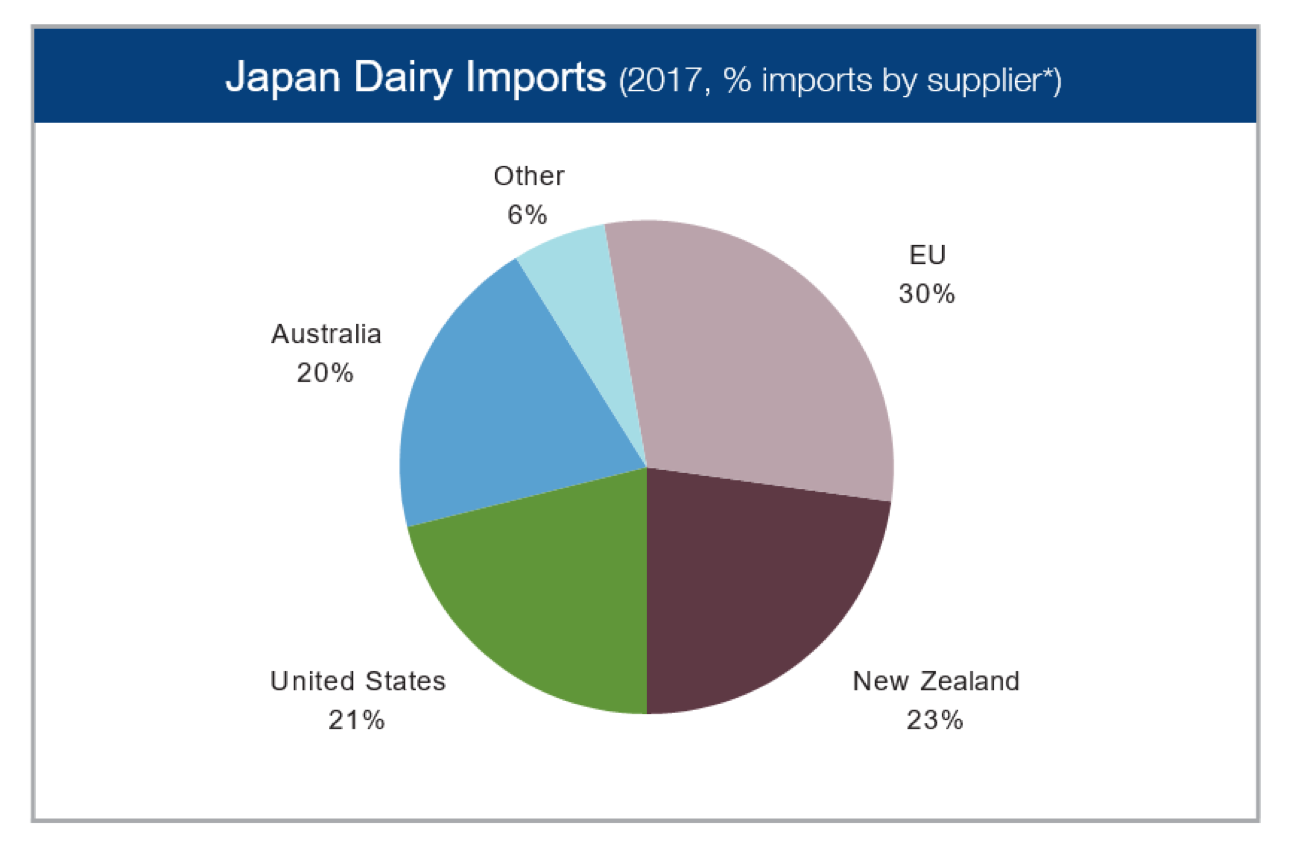-
Japan's Milk Problem Has a U.S. Solution
By Brad Scott November 8, 2018- Tweet
Spend time in a city three times the population of Chicago and you are reminded that 95% of the world’s potential dairy consumers live outside the U.S.

Photo of Tokyo: Ryoji Iwata from Unsplash
Editor's note: Brad Scott is one of four U.S. farmers on the Dairy Management Inc. board traveling in Asia this week to examine the dairy checkoff program's investment in exports. See day-by-day highlights of the trip here.
TOKYO -- This urbanized country of 126 million people needs more milk than a dwindling number of aging Japanese farmers can produce.
Fortunately, U.S. dairy farmers are able to produce plenty of milk shipped to Japan in the form of whey, lactose and the dairy product the Japanese love most, cheese.
It seems like a simple, win-win proposition.
But as three fellow U.S. dairy farmers and I are learning on a mission to Japan and Hong Kong this week, global dairy trade is anything but simple. You have to work continuously at relationships, never taking them for granted, especially when aggressive competitors can't wait to push you aside.
We're here as board members of Dairy Management Inc., sizing up our investment to increase exports through the U.S. Dairy Export Council.
U.S. milk for countries with a shortage
Spend time in a city like Tokyo, three times the size of Chicago, and you are reminded that 95 percent of the world’s population lives outside the United States.
Watch telephone interview with Brad Scott on RFD-TV
Unlike the United States, many countries are unable to produce enough milk to keep up with their own domestic demand.
Japan is among these milk-deficit countries. Since 2000, Japanese milk production is down 14 percent.
Several reasons are behind the decline. Many Japanese farmers have reached retirement age with no one to take over the farm, so they just leave the business.
A series of natural disasters—most recently an earthquake on Hokkaido (the center of milk production in Japan)—has further hindered growth.
Japan has a growing problem. We have a solution: continue to increase U.S. exports here.
Several societal trends make Japan a promising market for U.S. dairy farmers to get a strong return for our investment in exports:
- Waning agriculture sector. Japan is a nation of 126 million people, but agriculture comprises only 1 percent of the GDP (Gross Domestic Product). Japan must import food to survive.
- Huge urban population. Japan is the 10th most populous nation in the world, just ahead of Mexico, U.S. dairy's top export customer. Only 8% of Japan’s population lives in rural areas.
- Desire for U.S. dairy products. U.S. dairy exports to Japan were valued at $291 million last year, a 41 percent increase over 2016.
How milk from my farm ends up in Japan
My family's California farm has 1,100 cows. Milk from those cows goes to our own creamery and processing facility.
There, we produce products for frozen yogurt sold by Menchie's, TCBY and Yogurtland. These are international companies.
On Monday, our group visited a Menchie's store in Tokyo. My fellow farmers and I had the satisfying experience of knowing the milk in these tasty treats may have come from my cows in California.
.jpg?width=554&name=Brad%20at%20Menchies%20(4).jpg)
California dairy farmer Brad Scott smiles in front of a Menchie's frozen yogurt store in Tokyo this week knowing milk from his cows helps make a tasty treat in Asia and around the world.
Whenever I visit a chain that uses my milk, I look for opportunities to engage the staff. I enjoy talking to the employees about my farm and the cows that produce milk for their products.
Employees are delighted to learn how my farm cares for the well-being of our cows. To cite one example, we grow the cows' nutritious feed on our own land.
The Next 5% plan
Last year, the United States exported $5.48 billion worth of dairy products to countries around the world. On a total milk solids basis, U.S. exports were equivalent to 14.7 percent of U.S. milk production.
I truly believe we can increase that by five percentage points—to 20 percent of total milk solids production—as outlined by USDEC’s Next 5% plan.
Consider the opportunity for upside in Japan, our fifth largest customer. The country already imports nearly 10 percent of U.S. cheese exports, 6 percent of U.S. whey shipments and 13 percent of U.S. lactose sent to other countries.
That's impressive, but we can do much more for this dairy-friendly country.
Japan is world's biggest cheese importer
You might be surprised that Japan is the biggest cheese importer in the world by volume.
The country imported 272,776 metric tons in 2017, nearly 50,000 metric tons more than the second place nation, Russia. Trade was up seven percent through the first seven months of 2018.
Despite this steady growth, Japanese per capita cheese consumption is still only about 5.5 pounds per year. There is ample additional room for growth when you consider U.S. consumption of more than 36 pounds annually.
In the past, most of the cheese consumed in Japan was on pizza or in baked goods. That is changing. Applications are broadening.

On this trip, we’re seeing Western foods featuring cheese as well as fusion foods that merge cheese with more traditional Japanese tastes.
In one of the most significant and encouraging consumption shifts, consumers here are buying more natural cheese, including high-end artisan varieties, for stand-alone home consumption, often pairing it with wine.
Competition for market share
Over the past 25 years, U.S. suppliers have built strong relationships in the Japanese market. We are proud of that effort.
But the United States faces increasing competition, most notably the European Union. The EU’s market share in Japan has grown from 21 percent in 2010-14 to 30 percent in 2017. Our U.S. market share has remained flat at 21 percent.

The United States has roughly one-fifth of Japan's dairy import pie. Source: Global Trade Atlas, USDEC.
We can fend off the Europeans and other global dairy competitors with focus and perseverance as we move assertively toward The Next 5%..
Markets go up and down, but the long-range potential to significantly increase U.S. dairy exports remains a solid opportunity for dairy farmers and everyone else in the U.S. dairy industry.
Tasting the fruit of my labor here in Japan illustrates how the dairy checkoff program delivers value to U.S. dairy farmers. The future in Japan looks bright as USDEC and its member companies execute their plan to increase U.S. dairy exports to unprecedented heights.
Brad Scott helps manage Scott Bros. Dairy, which has been in continual operation in Southern California since 1913.
Learn more:
- Farmers Take U.S. Dairy Checkoff Program's Global Vision to Japan, Hong Kong
- Dairy Export Opportunities Series: Japan
- Global Boom of 65+ Population Opens Door for U.S. Whey Protein
Subscribe to the U.S. Dairy Exporter Blog
The U.S. Dairy Export Council fosters collaborative industry partnerships with processors, trading companies and others to enhance global demand for U.S. dairy products and ingredients. USDEC is primarily supported by Dairy Management Inc. through the dairy farmer checkoff. How to republish this post.
10 Most Recent Posts
Most Popular Posts in Past Year
Index of Posts by Topic
- #GotDairyJobs (4)
- About USDEC (66)
- Africa (6)
- Australia (4)
- Blog (8)
- Brazil (4)
- Canada (20)
- Central America (1)
- Cheese (58)
- Chile (1)
- China (54)
- Common food names (7)
- Company News (19)
- Consistent Supply (1)
- Crisis Management (3)
- Cuba (2)
- Dairy (6)
- Dairy checkoff (9)
- Dairy Ingredients (5)
- Dairy Management Inc. (2)
- Dairy Resources (1)
- Dairy Supply Chain (1)
- Dairy Trends (5)
- Documentation (3)
- EU (24)
- Experts on Dairy Exports (4)
- Exporter of the Year (2)
- Exports (24)
- Farmer leaders (1)
- Farming (38)
- Food Aid (8)
- Food Safety (8)
- Foodservice (3)
- Free trade agreements (34)
- Future trends (1)
- Geographical Indications (GIs) (10)
- Global Marketing (86)
- Global Shipping Crisis (1)
- Got Jobs? (9)
- Indonesia (1)
- Innovation (17)
- Japan (17)
- Krysta Harden (1)
- Market Access (25)
- Market Conditions (268)
- Member Services (17)
- Mexico (41)
- Middle East (9)
- Middle East & North Africa (3)
- Middle East/North Africa (9)
- Milk (4)
- Milk Protein Concentrate (MPC) (2)
- New Zealand (11)
- Next5% (20)
- Nonfat Dry Milk/Skim Milk Powder (8)
- Nutrition (19)
- Product Innovation (6)
- Protein (4)
- Regulations (5)
- Research & Data (326)
- Russia (3)
- Singapore (10)
- South America (8)
- South Korea (10)
- Southeast Asia (25)
- Strategic Insights (1)
- Supply (1)
- Sustainability (26)
- Technology (2)
- ThinkUSADairy (5)
- TPM23 (1)
- TPP (13)
- Traceability (8)
- Trade Barriers (5)
- Trade Data (7)
- Trade Policy (72)
- TTIP (5)
- UHT Milk (7)
- USMCA (2)
- Vietnam (4)
- Whey (6)
- Whey Ingredients (2)
- Whey products (10)
- Whole Milk Powder (WMP) (3)
- World Dairy Expo (1)
- World Milk Day (1)
- Yogurt (1)
Index of Posts by Date, Author
- June 2021 (13)
- March 2015 (12)
- September 2015 (12)
- April 2015 (11)
- December 2015 (11)
- March 2014 (10)
- February 2015 (10)
- October 2015 (10)
- October 2014 (9)
- June 2015 (9)
- July 2015 (9)
- November 2015 (9)
- March 2016 (9)
- October 2019 (9)
- September 2013 (8)
- May 2015 (8)
- August 2015 (8)
- January 2016 (8)
- February 2016 (8)
- March 2017 (8)
- December 2018 (8)
- May 2019 (8)
- December 2019 (8)
- June 2014 (7)
- November 2016 (7)
- May 2017 (7)
- May 2018 (7)
- July 2020 (7)
- June 2023 (7)
- July 2016 (6)
- August 2018 (6)
- October 2018 (6)
- November 2018 (6)
- February 2019 (6)
- June 2019 (6)
- August 2019 (6)
- March 2020 (6)
- April 2020 (6)
- June 2020 (6)
- June 2022 (6)
- February 2014 (5)
- June 2016 (5)
- August 2016 (5)
- September 2016 (5)
- December 2016 (5)
- February 2017 (5)
- July 2017 (5)
- October 2017 (5)
- January 2018 (5)
- April 2018 (5)
- June 2018 (5)
- July 2018 (5)
- September 2018 (5)
- January 2019 (5)
- March 2019 (5)
- April 2019 (5)
- July 2019 (5)
- September 2019 (5)
- November 2019 (5)
- January 2020 (5)
- August 2020 (5)
- October 2020 (5)
- April 2021 (5)
- January 2022 (5)
- May 2013 (4)
- September 2014 (4)
- April 2016 (4)
- May 2016 (4)
- October 2016 (4)
- January 2017 (4)
- April 2017 (4)
- June 2017 (4)
- August 2017 (4)
- September 2017 (4)
- December 2017 (4)
- February 2018 (4)
- February 2020 (4)
- May 2020 (4)
- February 2022 (4)
- September 2022 (4)
- April 2023 (4)
- December 2023 (4)
- November 2017 (3)
- March 2018 (3)
- September 2020 (3)
- December 2020 (3)
- February 2021 (3)
- May 2021 (3)
- August 2021 (3)
- December 2021 (3)
- March 2022 (3)
- April 2022 (3)
- May 2022 (3)
- October 2022 (3)
- December 2022 (3)
- May 2023 (3)
- July 2023 (3)
- November 2023 (3)
- March 2011 (2)
- June 2011 (2)
- September 2011 (2)
- March 2012 (2)
- June 2012 (2)
- July 2012 (2)
- March 2013 (2)
- July 2013 (2)
- November 2020 (2)
- January 2021 (2)
- March 2021 (2)
- July 2021 (2)
- September 2021 (2)
- October 2021 (2)
- November 2021 (2)
- July 2022 (2)
- August 2022 (2)
- January 2023 (2)
- March 2023 (2)
- October 2023 (2)
- January 2024 (2)
- February 2024 (2)
- April 2024 (2)
- June 2024 (2)
- July 2024 (2)
- November 2024 (2)
- December 2024 (2)
- February 2025 (2)
- June 2025 (2)
- July 2025 (2)
- September 2025 (2)
- November 2025 (2)
- January 2010 (1)
- February 2010 (1)
- March 2010 (1)
- April 2010 (1)
- May 2010 (1)
- June 2010 (1)
- July 2010 (1)
- August 2010 (1)
- September 2010 (1)
- October 2010 (1)
- November 2010 (1)
- December 2010 (1)
- January 2011 (1)
- February 2011 (1)
- April 2011 (1)
- May 2011 (1)
- July 2011 (1)
- August 2011 (1)
- October 2011 (1)
- November 2011 (1)
- December 2011 (1)
- January 2012 (1)
- February 2012 (1)
- April 2012 (1)
- August 2012 (1)
- September 2012 (1)
- October 2012 (1)
- November 2012 (1)
- December 2012 (1)
- January 2013 (1)
- February 2013 (1)
- April 2013 (1)
- June 2013 (1)
- August 2013 (1)
- October 2013 (1)
- November 2013 (1)
- December 2013 (1)
- January 2014 (1)
- April 2014 (1)
- May 2014 (1)
- November 2022 (1)
- February 2023 (1)
- August 2023 (1)
- September 2023 (1)
- March 2024 (1)
- May 2024 (1)
- August 2024 (1)
- September 2024 (1)
- October 2024 (1)
- January 2025 (1)
- March 2025 (1)
- April 2025 (1)
- May 2025 (1)
- August 2025 (1)
- December 2025 (1)
- USDEC (183)
- USDEC Staff (163)
- Alan Levitt (119)
- Tom Suber (41)
- Margaret Speich (22)
- Marc A.H. Beck (15)
- Vikki Nicholson-West (11)
- Angélique Hollister (11)
- Tom Vilsack (8)
- Jaime Castaneda (7)
- Matt McKnight (7)
- Véronique Lagrange (7)
- Margaret Speich and Mark O'Keefe (7)
- Ross Christieson (7)
- Paul Rogers (6)
- Shawna Morris (5)
- William Loux (5)
- Alan Levitt and Marc Beck (5)
- Krysta Harden (4)
- USDEC Communications (3)
- Kristi Saitama (3)
- Marilyn Hershey (3)
- Brad Gehrke (3)
- Tom Quaife (2)
- Nick Gardner (2)
- Jim Mulhern (2)
- Alan Levitt and William Loux (2)
- Kara McDonald (2)
- Luke Waring (2)
- Merle McNeil (2)
- Andrei Mikhalevsky (1)
- Rodrigo Fernandez (1)
- Dermot Carey (1)
- Jeremy Travis (1)
- Annie Bienvenue (1)
- Ross Christieson and Shawna Morris (1)
- Becky Nyman (1)
- Paul Rogers and Tom Quaife (1)
- Rick Ortman (1)
- Tony Rice (1)
- Barbara O’Brien (1)
- Paul Rogers and Mark O'Keefe (1)
- Dalilah Ghazalay (1)
- Amy Wagner (1)
- Mitchell Bowling (1)
- Erica Louder (1)
- Brad Scott (1)
- Amy Foor (1)
- Scott Lantz (1)
- Sandra Benson (1)
- Errico Auricchio (1)
- Jaclyn Krymowski (1)
- Krysta Harden, USDEC President and CEO (1)
.png)

